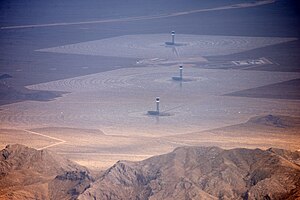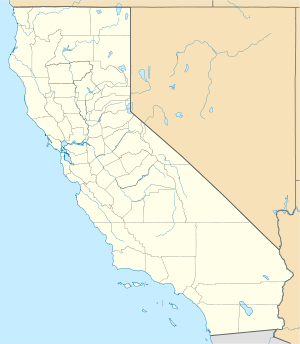Ivanpah solar thermal power plant
| Ivanpah Solar Electric Generating System | |||
|---|---|---|---|
| Aerial view of the three fields | |||
| location | |||
|
|
|||
| Coordinates | 35 ° 34 '12 " N , 115 ° 28' 12" W | ||
| country | United States of America | ||
| Data | |||
| Type | Solar tower power plant | ||
| Primary energy | solar power | ||
| power | 392 megawatts | ||
| operator | BrightSource Energy , Bechtel Corporation | ||
| Start of operations | 2013 | ||
| turbine | 3 SST-900 steam turbines from Siemens | ||
| Energy fed in 2016 | 703 GWh | ||
| Energy fed in since commissioning | 1775 GWh | ||
| Website | http://ivanpahsolar.com/ | ||
| was standing | December 31, 2016 | ||
The Ivanpah Solar Electric Generating System (ISEGS) is a solar thermal power plant in the Mojave Desert in the northeastern San Bernardino County ( California ), 60 km south-west of Las Vegas . With a nominal output of 392 MW , it was the world's largest solar thermal power plant at the beginning of 2014. 173,500 heliostats (each with two mirrors) focus the solar radiation on solar towers . The project is being carried out by the Israeli company BrightSource Energy , which specializes in solar power plants, and the American company Bechtel Corporation .
The attachment
The largest solar-powered steam turbine generator unit to date was commissioned for the first of the three power plant blocks. BrightSource Energy supplies the solar tower technology Luz Power Tower 550 technology (LPT 550). The SST-900 steam turbine from Siemens used has an output of 123 MW. Construction began in October 2010. In October 2013, the first construction phase in test mode fed electricity into the grid for the first time, the opening date was February 13, 2014.
The output of 392 MW consists of three systems: 126 MW and two 133 MW. The reflection area per heliostat is 15.2 m² and the total reflection area 2.6 million m². The closed steam cycle requires 0.11 liters of water per kilowatt hour, for coal-fired power plants it is 1.7 to 2 l / kWh and for nuclear power plants 2.7 l / kWh. Of the reserved land in the Mojave Desert, a low-precipitation region with 33 cm of annual precipitation, only 8% has so far been used for this facility. In addition, more power can be achieved per area with the technology used than with a photovoltaic power plant.
Installation
After three years of construction and a six-month test run, the system went online on February 13, 2014. The cost was $ 2.18 billion.
The technology used has the advantage over photovoltaics that predominantly conventional units and components are installed, which lowers the initial and operating costs. With the start of operations, the staff consists of 65 employees in 24-hour shifts. This number is expected to decrease as the operating time increases due to increasing automation. It is planned that robots clean the mirrors and protect them from weeds and small bushes.
The 16 square kilometer power plant project is located on Interstate 15, north of the Ivanpah settlement, not far from the California-Nevada border. Nearby are the Mojave National Preserve and the Mesquite Wilderness and Stateline Wilderness areas. The power plant can be seen from there. The advantage of the location is that the distribution network of the Hoover power plant and the greater Las Vegas and Los Angeles areas are adjacent.
The United States Department of Energy is backing the project with a $ 1.375 billion loan guarantee, the largest ever approved for a solar project. The total costs of the project have not been published. BrightSource has contracts under which approximately two-thirds of the energy it produces will be sold to Pacific Gas and Electric and the remainder to Southern California Edison .
According to official information, all three power plants generate 1079.2 GWh of electrical energy per year. This would give the power plants around 2800 full load hours.
The positioning of the heliostats on the superheating boilers in the towers turned out to be the most important operational problem in the first few months. Uncontrolled mirror rotations can only be checked and repaired at night, as the ambient heat prevents daytime work. After three months of network operation, 3% to 5% of the mirrors are not precisely aligned. In addition to the loss of performance, the false reflection can be dangerous for external employees and especially due to glare for drivers on the nearby motorway. The Japanese company Nihon Dengyo Kosa has developed a video surveillance solution to detect faulty heliostats and report them to the operations center. The solution is expensive and there are no plans to install the monitor system.
developments
For the time being, only 8% of the reserved desert land will be used by the system. With the experience gained, the operator is planning a plant with the same technology in southern California near Arizona with two units with 485 MW. Construction is scheduled for three years, but there are difficulties with the necessary permits. In addition, other suitable areas with high levels of solar radiation are far away from the supply areas, so that the operator - as is usual in the USA - has to set up his own electricity transmission network, which is expensive and tedious. NRG wants to gain further experience with the existing system. The objections to the necessary permits in California with its environmental legislation are complex.
Environmental impact
According to the operator consortium, Ivanpah will save 13.5 million tons of carbon dioxide in its 30-year lifetime, which is equivalent to the carbon dioxide emissions of two million cars. Opponents, however, criticize the project's large space requirements and the high construction costs. Dozens of birds have already died during the months of testing. Among the birds were, for example, a peregrine falcon , a diver , two hawks , four night falcons and a number of wood warblers and sparrows . Some of the dead birds have singed their feathers.
Bird experts assume that some of the birds either collide with the building parts in flight or mistake the shimmering surfaces for a lake and get caught in the mirror structures after landing and no longer escape. However, a large number of the birds seem to be killed by the great heat when the bundled sun rays fly through them. These animals have since been nicknamed streamers because some even catch fire and leave clouds of smoke in the sky. In a two-year study, the responsible state and federal supervisors want to observe the effects of the facility on the bird world. 95 birds were affected in April 2014 and 80 birds in May. The operator must report the number of birds that have died to the Californian Energy Commission. As a first countermeasure, birds should be scared off by calls of birds of prey. According to Welt Online , environmentalists put the number of birds killed annually at up to 28,000, while the operating company speaks of a maximum of 1,000 birds a year. The Associated Press relayed the Ivanpah bird death claim of 28,000, leading to a front page alert about Concentrated Solar Power (CSP). However, this information was not based on measured facts, rather it was speculative figures from an investment opponent.
Energy fed in
The energy fed in by Ivanpah had the following values in GWh .
| year | Ivanpah 1 | Ivanpah 2 | Ivanpah 3 | ISEGS total | ||||||||
|---|---|---|---|---|---|---|---|---|---|---|---|---|
| Sun | natural gas | Total plant 1 |
Sun | natural gas | Total plant 2 |
Sun | natural gas | Total plant 3 |
Sun | natural gas | total | |
| 2014 | 151.97 | 151.97 | 129.26 | 129.26 | 137.86 | 137.86 | 419.09 | 419.09 | ||||
| 2015 | 201.07 | 8.90 | 209.98 | 210.52 | 8.53 | 219.04 | 215.57 | 8.53 | 224.10 | 627.16 | 25.96 | 653.12 |
| 2016 | 243.48 | 12.18 | 255.66 | 190.41 | 9.27 | 199.68 | 236.68 | 11.02 | 247.70 | 670.58 | 32.46 | 703.04 |
The "Fossil Backup" is made available from natural gas and offers up to 5% of the total output.
Web links
- California: World's largest solar power plant has started operation , Spiegel online from February 15, 2014
- Large solar power plant with teething problems, VDI-nachrichten.de, Friday, July 18, 2014, issue No. 29, Technology and Economy, Energy Generation
Individual evidence
- ↑ a b c d e f Large solar power plant with teething problems . VDI-nachrichten, July 18, 2014, No. 29/30 2014, p. 14
- ↑ Solar energy plans in California gets new partner in NRG. in Power Engineering International, October 28, 2010
- ↑ BrightSource & Bechtel Partner on 440-MW Ivanpah CSP Project , in RenewableEnergyWorld.com, September 10, 2009
- ↑ Siemens press release: Siemens to supply 123-MW steam turbine-generator set for solar thermal power plant in California
- ↑ Siemens information on the SST-900 steam turbine
- ↑ IWR: Solar thermal power plants: New test facility in Jülich and first electricity for a major US project on October 18, 2013, accessed on October 21, 2013.
- ↑ Huge thermal plant opens as solar industry grows. March 13, 2015, accessed April 2, 2015 .
- ^ World's Largest Solar Thermal Power Project at Ivanpah Achieves Commercial Operation , corporate-ir.net, accessed February 13, 2014.
- ↑ BrightSource Files for $ 250M IPO: A Closer Look. In: www.greentechmedia.com. Retrieved May 23, 2016 .
- ↑ State of California Energy Resources Conservation and Development Commission (Energy Commission Staff's Opening Brief) (PDF; 136 kB)
- ↑ CBC: BrightSource solar plant sets birds on fire as they fly overhead article from August 18, 2014
- ↑ Ivanpah becomes a death trap for birds ( Memento of the original from February 28, 2014 in the Internet Archive ) Info: The archive link was automatically inserted and not yet checked. Please check the original and archive link according to the instructions and then remove this notice. , enveya.com, article from February 20, 2014
- ↑ Hiss, and again a bird falls dead from the sky. Welt Online, September 23, 2014, accessed September 28, 2014 .
- ^ Susan Kraemer: For the Birds: How Speculation Trumped Fact at Ivanpah ( English ) September 3, 2014. Archived from the original on February 15, 2017. Retrieved on April 13, 2017.
- ^ Energy Information Administration : Ivanpah 1, Annual . In: Electricity Data Browser . Retrieved April 13, 2017.
- ^ Energy Information Administration : Ivanpah 2, Annual . In: Electricity Data Browser . Retrieved April 13, 2017.
- ^ Energy Information Administration : Ivanpah 3, Annual . In: Electricity Data Browser . Retrieved April 13, 2017.


